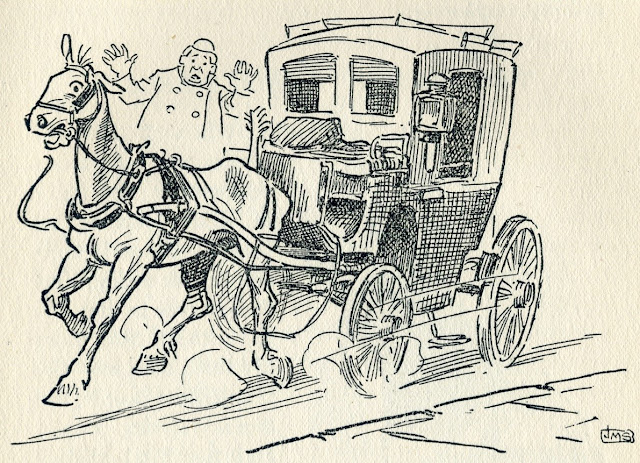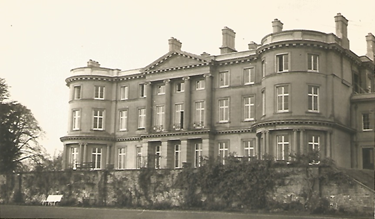‘Black, white and amber’: Newport in the cartoons of J. M. Staniforth
‘Black, white and amber’: Newport in the cartoons of
J. M. Staniforth
I
have been working on the career of Joseph Morewood Staniforth (‘JMS’) (1863-1921)
for some years, and have published a number of journal articles and book
chapters on him and his cartoons, including an Oxford Dictionary National
Biography entry. Staniforth was, essentially, a Cardiffian, born in
Gloucester in 1863 but growing up from a young age in Cardiff, and living there
until his move to Devon in 1919. Leaving school aged fifteen, he became a
printer’s apprentice with the Western Mail before going on to a highly
successful career as an illustrator and a cartoonist. His cartoons appeared in
the Evening Express, Western Mail, and in the British Sunday
newspaper the News of the World, and he drew many series of picture
postcards, as well as contributing illustrations for a variety of political
pamphlets, magazines, and memoirs (including The Wit and Wisdom of Lord
Tredegar (1911)
 |
| Western Mail included with obituary 10th December 1921 |
 |
| A rare photograph of Staniforth published in the Western Mail, 24 July 1909 |
 |
| ‘The feeling of a Newport cabman when his horse runs away’ The Wit and Wisdom of Lord Tredegar (Cardiff, 1911), p.59, |
In
this short blog I explore some of the cartoons Staniforth drew that took as
their topic Cardiff’s neighbour, Newport.
‘Weighed in
the Balance’, Western Mail, 10 July
1895
Mr E. M. Underdown (U.)
Each carpet-bagger round the country sails
And tries to please the groundlings with his tales
But, to the Balance! Let each candidate
Show forth his true position, square and
straight!
At Newport note the aspect of affairs:
Mr A. Spicer (L.)
Heavy with local interests, stocks, and shares.
Down, down, does Underdown the balance weigh,
Whilst his opponent in the air away
Doth sail, a carpet-bag his only claim,
To turn the scale against his rival's name.
Staniforth
was a great follower of rugby union, and his ‘football’ cartoons for Cardiff’s Evening
Express were a very popular feature in the 1890s and 1900s, sometimes
accompanied by verses penned by the Western Mail’s ‘resident bard’,
‘Idris’. The prowess and fortunes of Newport RFC were inevitably to the fore,
and in Staniforth’s mind there was little question but that Newport was a Welsh
club whose successes reflected glory on Welsh rugby in general. This is evident
in the following cartoon which marked successive defeats suffered by Leicester
RFC (the ‘Tigers’) at both Newport and Llanelli.
‘The Passing of the Tiger’, Evening Express, 8 November 1902
To make things warm for the Uskside town!
He was vainly proud of his strength and might:
Seven teams in succession he’d scotched outright!
His captain – Jones – is a famous man:
A cricketer, too, in the foremost van.
He has trained his team in the artful ways
That long have won for the Welsh such praise!
But still there was seemingly more to learn,
For the Tiger came bounding so fierce and stern!
But he met the Dragon at Newport first,
And the Dragon slaked in his gore his thirst!
And further still, to enhance his shame,
Llanelly assisted the beast to tame –
Llanelly, of all teams under the sun,
Completing what Newport had left undone!
And now the poor Tiger his eastward hied,
Shorn on his vengeance, his strength, and pride;
And ‘twill be some time – no need to explain
- Ere he bends his steps into Wales again!
IDRIS
‘Arrival of the Liberal Leader at the Newport Railway
Station’, Western Mail, 1 December 1903
Staniforth
had begun his career illustrating many events for newspapers (in the days
before photographs were carried by most dailies) and, from time to time, he
continued to turn out the odd set-piece sketch. Here he reconstructs the
arrival of the Liberal leader (and future Prime Minister) Sir Henry
Campbell-Bannerman at Newport in 1903, greeted by a bevy of prominent local
Liberal worthies, including a number of members of Parliament (D. A. Thomas,
the Liberal MP for Merthyr Boroughs, resident at Llanwern House, is one clearly
depicted, as is the miners’ leader William Brace of Risca, who would be elected
MP for South Glamorgan in 1906). Campbell-Bannerman spoke at the Tredegar Hall
in Newport only ten days after Joseph Chamberlain had addressed another large
meeting at the same venue. Staniforth’s skill in capturing the politician’s
mannerisms is evident in a second sketch appearing in the same edition:
Attitudes of the Liberal Leader when speaking at
Newport last night
Staniforth
regularly used characters as ‘stereotypes’, representing countries, peoples,
cities and notions of ‘public opinion’. Classically-dressed females were
deployed to depict the rival Welsh urban centres when the journalist George R.
Sims favourably compared the state of Newport with that of its neighbours.
According to Sims in his ‘Human Wales’ report, ‘I have been told that there is
very little bad housing in Newport, and I am glad. When one has been ferrreting
for a fortnight in foul courts and “terraces,” climbing crazy stairways, with
broken bannisters, in order to pass from rooms unfit to live in to rooms unfit
to die in, the prospect of a pilgrimage that shall be pleasant instead of
painful is indeed a relief.’ He summarised that ‘every town has its troubles,
but Newport has fewer than any that I have yet visited’. Hence Staniforth’s
portrayal of ‘slum’ besmirched Swansea, Ebbw Vale, Cardiff and Merthyr looking
on in dismay as Newport shows a ‘clean tail’.
A Clean Tail: The Envy of All Beholders, Western
Mail, 5 July 1907
As
someone who was privileged to serve as a Royal Commissioner with the Royal
Commission on the Ancient and Historical Monuments of Wales for ten years, I
was delighted to come across ‘JMS’s cartoon of 7 August 1908, which referenced
both the establishment of the RCAHMW and the intervention of Lord Tredegar to
protect Newport Castle against a local authority plan which would have
demolished it to make space for a new bridge across the Usk.
‘In Peril’, Western Mail, 8 August 1908
 |
| Newport Castle: ‘Save me,
Lord Tredegar, save me from that vandal!’ |
The
last cartoon appeared during the last months of the First World War, and was
inspired by a speech delivered by the Prime Minister, David Lloyd George at
Newport Town Hall. Lloyd George had already addressed an open-air gathering in
Shaftesbury Park, and now took the opportunity to urge his audience to do
whatever they could to drive up the output of coal. This was vital, he argued,
not only for the British economy, but also for those of its continental allies.
‘Coal means to these
countries not merely comfort and warmth, it means for their railways, their
munition works, the power to defend them against the brutal enemy. It means
emancipation to the world. I ask the coal workers to look across the seas, and
they will see there men armed to trample down the liberties of the world. What
I say to them is “Sling coal at them.” (Cheers.)’ Staniforth’s cartoon shows
the collier (complete with ‘Dai cap’, tea caddy and pipe) being appealed to by
female figures including Britannia, and Marianne (representing France).
‘A Pet of
the Ladies’, Western Mail, 13 August 1918
Many
of Staniforth’s cartoons have been digitised and are available online via three
websites, all originally funded by the Heritage Lottery Fund, developed by
Waters Creative of Swansea, and now supported by University College Cork where
I work.
Cartooning
the First World War www.cartoonww1.org[WC1]
was the original website, and this carries all Staniforth’s cartoons published
during the First World War, together with short explanatory notes providing
some background, context and interpretation for each image.
Cartooning
the Post-War World www.postwarworldcartoons.org[WC2]
carries all Staniforth’s cartoons from the Armistice of 1918 through to
Staniforth’s death in December 1921.
Cartooning
the Road to War www.roadtowarcartoons.org[WC3]
carries a wide selection of Staniforth’s pre-First World War cartoons, some
stretching back to the early 1890s. Although the original focus was on those
cartoons which commented on international relations and imperial conflicts,
this site now carries images dealing with all manner of topics, domestic as
well as international, and will continue to develop over coming years.
Each
of these websites and their 3500+ cartoons (still only about a third of his
total output) can be searched in various ways, by date, by event, by individual
depicted, and by topic, as well as by title or keyword. Together I hope they
constitute a valuable resource for scholars and enthusiasts of all ages. Please
do not hesitate to contact me if you would like any further advice or help with
using this resource.
Chris Williams








